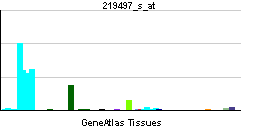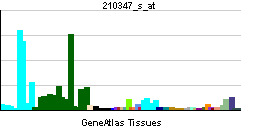BCL11A
| B-cell CLL/lymphoma 11A (zinc finger protein) | |||||||||||
|---|---|---|---|---|---|---|---|---|---|---|---|
| Identifiers | |||||||||||
| Symbols | BCL11A ; BCL11A-L; BCL11A-S; BCL11A-XL; CTIP1; EVI9; FLJ10173; FLJ34997; KIAA1809 | ||||||||||
| External IDs | Template:OMIM5 Template:MGI HomoloGene: 11284 | ||||||||||
| |||||||||||
| RNA expression pattern | |||||||||||
 | |||||||||||
 | |||||||||||
 | |||||||||||
| More reference expression data | |||||||||||
| Orthologs | |||||||||||
| Template:GNF Ortholog box | |||||||||||
| Species | Human | Mouse | |||||||||
| Entrez | n/a | n/a | |||||||||
| Ensembl | n/a | n/a | |||||||||
| UniProt | n/a | n/a | |||||||||
| RefSeq (mRNA) | n/a | n/a | |||||||||
| RefSeq (protein) | n/a | n/a | |||||||||
| Location (UCSC) | n/a | n/a | |||||||||
| PubMed search | n/a | n/a | |||||||||
B-cell CLL/lymphoma 11A (zinc finger protein), also known as BCL11A, is a human gene.[1]
This gene encodes a C2H2 type zinc-finger protein by its similarity to the mouse Bcl11a/Evi9 protein. The corresponding mouse gene is a common site of retroviral integration in myeloid leukemia, and may function as a leukemia disease gene, in part, through its interaction with BCL6. During hematopoietic cell differentiation, this gene is down-regulated. It is possibly involved in lymphoma pathogenesis since translocations associated with B-cell malignancies also deregulates its expression. Five alternatively spliced transcript variants of this gene, which encode distinct isoforms, have been reported.[1]
References
Further reading
- "Toward a complete human genome sequence". Genome Res. 8 (11): 1097–108. 1999. PMID 9847074.
- Avram D, Fields A, Pretty On Top K; et al. (2000). "Isolation of a novel family of C(2)H(2) zinc finger proteins implicated in transcriptional repression mediated by chicken ovalbumin upstream promoter transcription factor (COUP-TF) orphan nuclear receptors". J. Biol. Chem. 275 (14): 10315–22. PMID 10744719.
- Nakamura T, Yamazaki Y, Saiki Y; et al. (2000). "Evi9 encodes a novel zinc finger protein that physically interacts with BCL6, a known human B-cell proto-oncogene product". Mol. Cell. Biol. 20 (9): 3178–86. PMID 10757802.
- Saiki Y, Yamazaki Y, Yoshida M; et al. (2001). "Human EVI9, a homologue of the mouse myeloid leukemia gene, is expressed in the hematopoietic progenitors and down-regulated during myeloid differentiation of HL60 cells". Genomics. 70 (3): 387–91. doi:10.1006/geno.2000.6385. PMID 11161790.
- Nagase T, Nakayama M, Nakajima D; et al. (2001). "Prediction of the coding sequences of unidentified human genes. XX. The complete sequences of 100 new cDNA clones from brain which code for large proteins in vitro". DNA Res. 8 (2): 85–95. PMID 11347906.
- Satterwhite E, Sonoki T, Willis TG; et al. (2001). "The BCL11 gene family: involvement of BCL11A in lymphoid malignancies". Blood. 98 (12): 3413–20. PMID 11719382.
- Martín-Subero JI, Gesk S, Harder L; et al. (2002). "Recurrent involvement of the REL and BCL11A loci in classical Hodgkin lymphoma". Blood. 99 (4): 1474–7. PMID 11830502.
- Küppers R, Sonoki T, Satterwhite E; et al. (2002). "Lack of somatic hypermutation of IG V(H) genes in lymphoid malignancies with t(2;14)(p13;q32) translocation involving the BCL11A gene". Leukemia. 16 (5): 937–9. doi:10.1038/sj.leu.2402480. PMID 11986957.
- Strausberg RL, Feingold EA, Grouse LH; et al. (2003). "Generation and initial analysis of more than 15,000 full-length human and mouse cDNA sequences". Proc. Natl. Acad. Sci. U.S.A. 99 (26): 16899–903. doi:10.1073/pnas.242603899. PMID 12477932.
- Ota T, Suzuki Y, Nishikawa T; et al. (2004). "Complete sequencing and characterization of 21,243 full-length human cDNAs". Nat. Genet. 36 (1): 40–5. doi:10.1038/ng1285. PMID 14702039.
- Gerhard DS, Wagner L, Feingold EA; et al. (2004). "The status, quality, and expansion of the NIH full-length cDNA project: the Mammalian Gene Collection (MGC)". Genome Res. 14 (10B): 2121–7. doi:10.1101/gr.2596504. PMID 15489334.
- Senawong T, Peterson VJ, Leid M (2005). "BCL11A-dependent recruitment of SIRT1 to a promoter template in mammalian cells results in histone deacetylation and transcriptional repression". Arch. Biochem. Biophys. 434 (2): 316–25. doi:10.1016/j.abb.2004.10.028. PMID 15639232.
- Liu H, Ippolito GC, Wall JK; et al. (2006). "Functional studies of BCL11A: characterization of the conserved BCL11A-XL splice variant and its interaction with BCL6 in nuclear paraspeckles of germinal center B cells". Mol. Cancer. 5: 18. doi:10.1186/1476-4598-5-18. PMID 16704730.
- Weniger MA, Pulford K, Gesk S; et al. (2006). "Gains of the proto-oncogene BCL11A and nuclear accumulation of BCL11A(XL) protein are frequent in primary mediastinal B-cell lymphoma". Leukemia. 20 (10): 1880–2. doi:10.1038/sj.leu.2404324. PMID 16871282.
- Szafranski K, Schindler S, Taudien S; et al. "Violating the splicing rules: TG dinucleotides function as alternative 3' splice sites in U2-dependent introns". 8 (8): R154. doi:10.1186/gb-2007-8-8-r154. PMID 17672918.
External links
- BCL11A+protein,+human at the US National Library of Medicine Medical Subject Headings (MeSH)
| This protein-related article is a stub. You can help Wikipedia by expanding it. |
This article incorporates text from the United States National Library of Medicine, which is in the public domain.